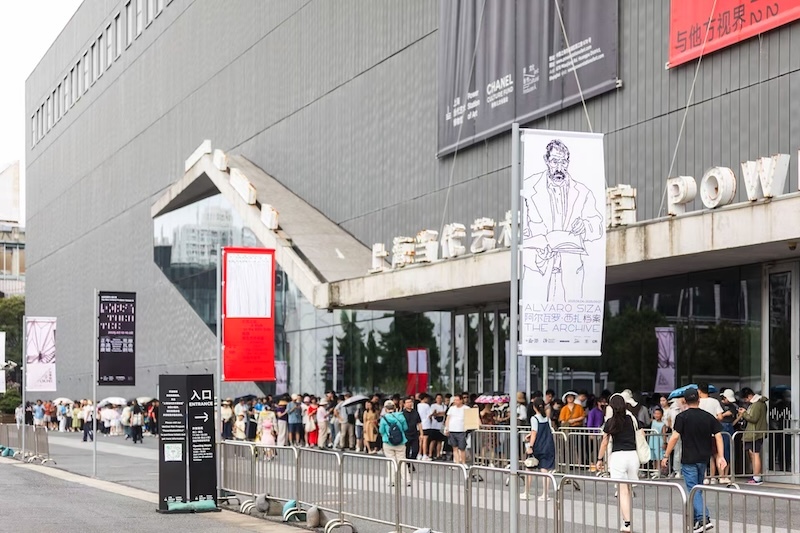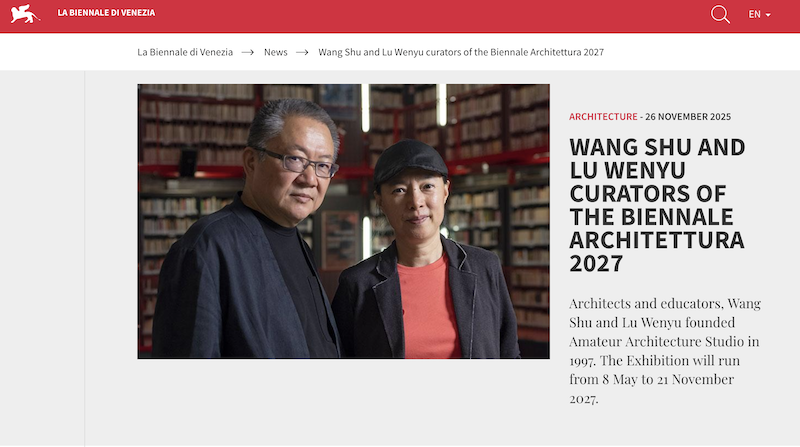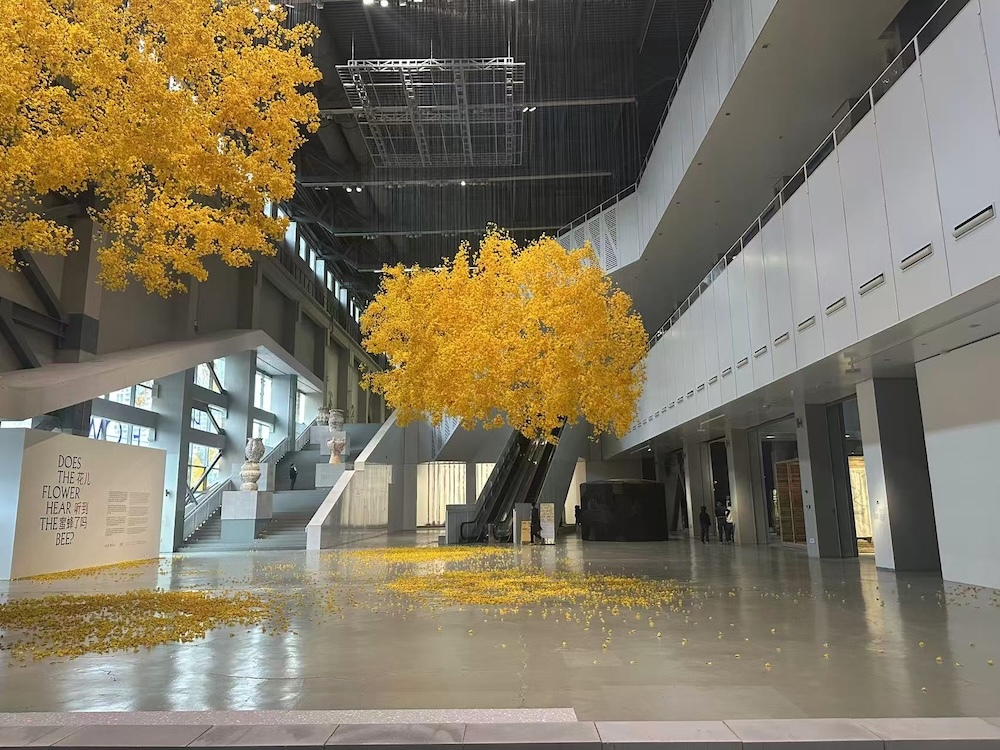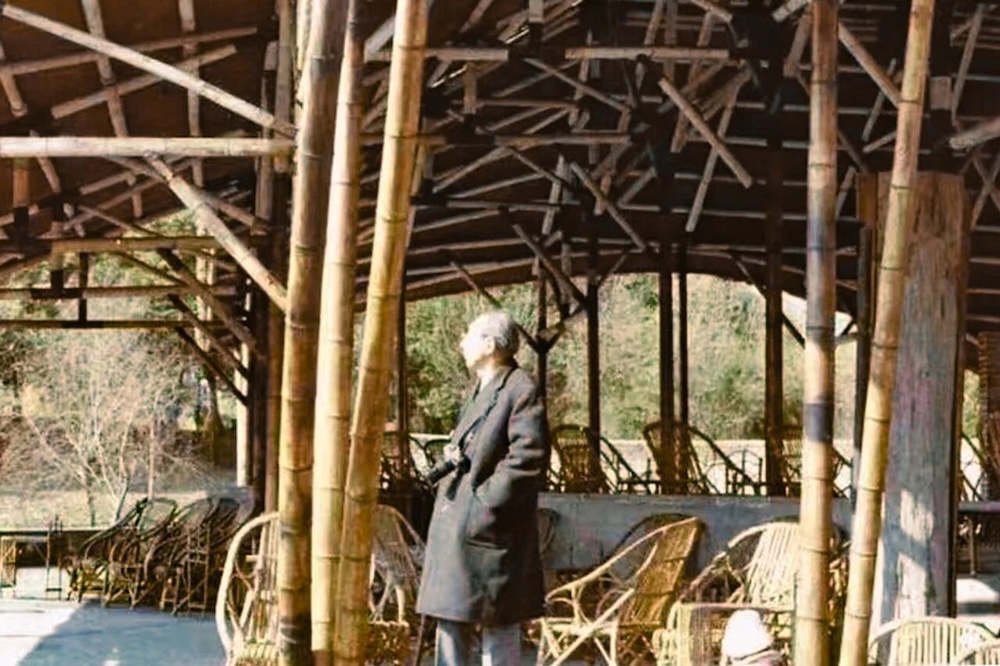
At 9:30 PM on August 10th, the Power Station of Art (PSA) Shanghai exhibition "I.M. Pei: Life as Architecture" concluded. Throughout its three-month run, the exhibition enjoyed a sustained period of enthusiastic audience participation, breaking PSA's single-day attendance records several times, totaling over 160,000 visitors. The highest single-day attendance was recorded on August 9th, with 7,265 attendees. The West Bund Art Museum's exhibition "Building Shanghai: Architecture, City, and Culture Since 1949," which closed on the same day, also evoked collective memories among Shanghai residents.
In fact, this spring and summer, many architectural theme exhibitions were held in Shanghai. From Siza and Gaudi to I.M. Pei and Liang Sicheng, architects met in Shanghai. The exhibitions were both independent and echoed each other, injecting new thinking into urban construction for the city of Shanghai.

On the final weekend of the "I.M. Pei: Life as Architecture" exhibition at the Power Station of Art in Shanghai, long lines of visitors lined up outside the museum.
"I.M. Pei: A Life Like Architecture" is the first comprehensive retrospective exhibition in mainland China. It uses over 400 exhibits (including drawings, architectural models, photographs, videos and documents from institutions and private collections) to outline I.M. Pei's century-long life. Many of these exhibits are on public display in mainland China for the first time.

"I.M. Pei: Life as Architecture" exhibition, I.M. Pei's glasses, 1960s

Shanghai held extraordinary significance for I.M. Pei. This city not only witnessed his youthful growth but also embodied his memories. This multicultural experience informed his later design philosophy of "interpreting tradition with a modern language." The most significant known influence of Shanghai on Pei was the International Hotel. Designed by Hungarian architect Hudec, inspired by Chicago skyscrapers, and jointly funded by the Four Banks Savings Association, this "tallest building in the Far East," completed in 1934, marked the beginning of Pei's architectural dreams. In the hearts of the Chinese at the time, this building symbolized an architectural ideal in which the modern and the national could coexist.

Old photos of the International Hotel
Also at the Power Station of Art (PSA), 92-year-old Portuguese architect and Pritzker Prize laureate Álvaro Siza presents his largest solo retrospective in Asia to date, titled "Álvaro Siza's Archives." Over 800 exhibits create a trans-temporal and intertextual architectural landscape, outlining the master's long and rich creative oeuvre.

Siza and I.M. Pei, two Pritzker Prize winners, are exhibited in the 5th and 7th floor exhibition halls of the Shanghai Power Station respectively.

Visitors to the "Álvaro Siza Archives" exhibition on the closing day of the "I.M. Pei Exhibition."
This wasn't the first time the two Pritzker Prize-winning architects had crossed paths. Around 1990, they worked on a project in the same urban area—the Manuel Calgarero Foundation project featured in the exhibition (located in Lisbon's Plaza de España). "Siza was responsible for the district's master plan, and I.M. Pei was commissioned to design the Museo Orientale. Although neither project ultimately came to fruition, the two masters had substantial contact during that period," said António Choupina, curator of the exhibition "Álvaro Siza's Archives," and a student and collaborator of Siza, in an exclusive interview with The Paper. He also believes that the triangular entrance of Porto's "Siza Wing" evokes both the tradition of Portuguese monastic architecture and a response to I.M. Pei's pyramidal entrance for the Louvre.

I.M. Pei (first from left) and Álvaro Siza (third from left) took a photo together.

Serralves Foundation – Siza Wing, Porto, Portugal, 2018–2022. Image © Fernando Guerra
From Siza and Gaudí to I.M. Pei and Liang Sicheng, architects meet in Shanghai
This dialogue also extends to the city.
Siza had always been passionate about sculpture. Later, by chance, he was transported to Barcelona by a trip and was captivated by the city and the works of Antoni Gaudí. He subsequently ended his sculpting journey and switched to architecture. A joint exhibition featuring Gaudí's work is currently on view at the Shanghai Jiushi Art Space on the Bund. While Gaudí's Catalan architecture may be situated far from Spain, its influence reaches across the globe. Perhaps the architectural components, historical photographs, and working manuscripts on display in this exhibition offer a glimpse into Siza's past.

Exhibition view of "Splendour Returns to Simplicity: Gaudí and His Times" at Shanghai Jiushi Art Space
In 1935, I.M. Pei left Shanghai to study in the United States. He first stayed briefly at the University of Pennsylvania in Philadelphia, where China's first generation of architects was trained. Fan Wenzhao, Yang Tingbao, Liang Sicheng, Tong Jun, Chen Zhi and others all graduated from the University of Pennsylvania.

Chinese students at the University of Pennsylvania. Second from left: Lin Huiyin; first from right: Chen Zhi. Photo provided by Chen Zhi's family.
In Hongkou, the Qukan Art Museum's "Pillars: Liang Sicheng and Lin Huiyin Academic Documents Exhibition" features Liang and Lin as representatives, depicting the lives and ideals of China's first generation of architectural scholars. This couple not only established the academic system for the study of Chinese architectural history in the 1930s but also participated in numerous important urban planning and architectural preservation projects. Numerous documents in the exhibition highlight the Liang and Lin families' connection to Shanghai. For example, in September 1928, Lin Huiyin wrote to Liang Qichao while passing through Shanghai on her way to visit relatives in Fuzhou before returning to China to establish the Department of Architecture at Northeastern University. In the letter, she reported her itinerary to her father-in-law, mentioning a visit to Chenghuangmiao Garden (now Yu Garden), using stationery from the then-current Cangzhou Hotel (Burlinton Hotel, the predecessor of the current JC Mandarin).

Lin Huiyin's letter to Liang Qichao, Shanghai, 1928, courtesy of Liang Sicheng's relatives
Liang Sicheng and Lin Huiyin also had further connections with Shanghai. In April 1936, the Architectural Society of China initiated the Chinese Architecture Exhibition, held at the former Shanghai Museum (now the Imaging Building of Changhai Hospital, 174 Changhai Road). Liang Sicheng, one of the core initiators, attended the exhibition and delivered a lecture titled "The Evolution of Wooden Architecture in my country Throughout the Ages." Lin Huiyin served as director of the exhibition group.

Old photos of Shanghai Museum

The Imaging Building of Changhai Hospital in Yangpu District (No. 174 Changhai Road, formerly the Shanghai Museum). Photo by Yin Shun
Ten years later, in 1946, I.M. Pei designed a Chinese Art Museum for his Harvard master's thesis, sited within the former Shanghai Museum. Departing from the then-popular large, gabled roofs with overhanging eaves, Pei envisioned a flat, square concrete structure clad in marble. The museum's exhibition halls were arranged around a scenic courtyard, seamlessly integrating the building with its natural surroundings. This early, unbuilt design bears numerous resemblances to the Suzhou Museum, built 60 years later.

A map of Shanghai's Jiangwan District (left) and a plan of the location of the "Shanghai Museum of Chinese Art" (1946) in the exhibition (right). Comparison shows that the road network still retains some of its past form.

I.M. Pei, Sectional Drawing of the Design for the Chinese Art Museum in Shanghai, for the Master of Architecture Thesis at the Harvard Graduate School of Design, 1946. Courtesy of the Francis L. Loeb Library, Harvard Graduate School of Design.
In a letter to his classmate Frederick S. Roth, I.M. Pei explained the motivation for his graduate thesis: "I have long been pondering how to express regional or 'national' characteristics in architecture... The difficulty lies in creating an architectural language that is essentially Chinese without resorting to any of the familiar Chinese architectural decorative elements and symbolic systems."

I.M. Pei's letter to his classmate Frederick Ross
This has also been the exploration of generations of Chinese architects since the 20th century. In 2016 and 2018, the Power Station of Art (PSA) launched the exhibitions "Citizen Metropolis: Shanghai: A Model of Modern Urbanism" and "Awakening Modernity: China's First Generation of Architects Graduated from the University of Pennsylvania," respectively, exploring Shanghai's urban history and architectural culture. Among these exhibits was Huagai Architects, founded in Shanghai in 1933 by three University of Pennsylvania alumni: Zhao Shen, Chen Zhi, and Tong Jun. As a "novelty-seeking" firm at the time, the firm abandoned traditional large-roof designs, leaving behind buildings in Shanghai that are still acclaimed and in use today.

“Awakening Modernity: China’s First Generation of Architects Graduated from the University of Pennsylvania,” exhibition view, Power Station of Art, Shanghai, 2018

Tong Jun, Jincheng Grand Theatre, now the Huangpu Theatre, Huagai Architects, 1934. Photo courtesy of Tong Jun's family.
Tong Ming, the curator of "Awakening Modernity," is the grandson of Tong Jun. He received his doctorate at Tongji University, and I.M. Pei also has a deep connection to Tongji University. Chen Congzhou, a Tongji University professor and expert on ancient architecture and landscape architecture, was a close friend of Pei. The two met in the late 1970s when Pei invited Chen Congzhou to design the gardens for the Xiangshan Hotel in Beijing.

Mr. I.M. Pei (left) and Mr. Chen Congzhou (right) at the Xiangshan Hotel
In 1981, I.M. Pei visited Tongji University for the first time. On October 24, 1985, he received a certificate of honorary professorship from Tongji University, his first honorary academic title in China. That same day, Pei gave a lecture titled "On My Recent Works and Thoughts." He stated that Chen Congzhou and Feng Jizhong of Tongji University were his good friends. He hoped that while Chinese architecture would absorb foreign technology, it would also maintain Chinese characteristics, believing that "roots must not be lost."

On April 25, 1981, Mr. I.M. Pei visited Tongji University and had academic exchanges with teachers and students of the Department of Architecture.

I.M. Pei (center) with Chen Congzhou (left) and Feng Jizhong (right)
Intertextuality with Paris: Urban Development Epitomized by "Architecture"
In a corner of Songjiang, Shanghai, the "Helou Pavilion," designed by Feng Jizhong in the early 1980s, arguably represents the first prototype experiment in "Chinese-ness" architecture. A model of this building, featured in the West Bund Art Museum's exhibition "Building Shanghai: Architecture, City, and Culture Since 1949," was hailed by Tongji University Vice President Li Xiangning, the exhibition's lead curator, as "a sacred place where Tongji constructs its modern tradition." Indeed, while unassuming at first glance, its details concealed, Helou Pavilion, rich in academic and cultural heritage, embodies the very continuity that the "Building Shanghai" exhibition seeks to explore: Shanghai's architecture and urban culture, both respectful of tradition and oriented toward the future.

Interior view of Helouxuan

The West Bund Art Museum's "Building Shanghai: Architecture, City, and Culture Since 1949" exhibition, featuring a model of the Helou Pavilion.
Li Xiangning explained the exhibition title, "Constructing Shanghai," by emphasizing process, participation, and continuity. He believes Shanghai is a city "built" by countless people—not only policymakers, architects, and construction workers, but also the daily actions and emotional investment of the general public.

Aerial photography of the East China Electric Power Building and its surroundings, 1994, by Lu Jie
From the early days of workers' new villages and monumental architecture to the development and opening up of Pudong and the establishment of Lujiazui, the World Expo and the development of the "One River, One Canal," these buildings and neighborhoods are not only spatial nodes but also sites of social memory. If Lujiazui shaped the city's image back then, today, with the continued development of public spaces along the "One River, One Canal," urban spaces are not only beautiful but also truly convenient living spaces for citizens and tourists. Whether along Suzhou Creek or within the West Bund area, cultural, leisure, and dining facilities invite the public to linger, and the quality of these spaces rivals that of international waterfronts like London and Paris. This is a reflection of contemporary Shanghai's cultural creativity.

Artist Ding Yi's public art work "Light Tower" is the 21st public art work to be installed along the Yangpu River. Image courtesy of Art Pioneer Studio
In 2021, the West Bund Art Museum collaborated with the Centre Pompidou on the exhibition "Paris Architecture (1948-2020): Witness to an Urban Process," which explored how Paris, one of the world's capitals, became a global model city. The exhibition showcased the visions of modern cities embodied by a new generation of post-World War II modern architects, including Renzo Piano, Jean Nouvel, Tadao Ando, Frank Gehry, and Rem Koolhaas. Some of the architects featured in the exhibition also have their buildings located in Shanghai, where they have also participated in the transformation of the city's historic districts.

Rock Bund Source, Source: David Chipperfield Architects

West Bund Art Museum, “Paris Architecture (1948-2020): Witness to Urban Progress,” exhibition view, 2021
In line with this, the Power Station of Art (PSA), one of the first contemporary art institutions in China to integrate architecture and cities into its exhibition and research, has presented over 20 research exhibitions by architects (the "Urban and Architectural Research Series"), showcasing the achievements of Pritzker Prize-winning architects such as Jean Nouvel, Renzo Piano, Arata Isozaki, Toyo Ito, and Shigeru Ban in the field of contemporary architecture.

“Jean Nouvel: In My Head, In My Eyes… Belonging…” Exhibition view, Power Station of Art, Shanghai, 2019
For Shanghai, the practices brought by these architects in Paris and Tokyo provide references and inspiration for many issues, including the protection of historical and cultural buildings, the survival of industrial heritage, the planning, construction and management of urban renewal, urban aesthetics, and the ideal urban living environment.

“Modern Paris 1914–1945: Architecture, Design, Film, Fashion,” exhibition view, Power Station of Art, Shanghai, 2023
In the summer of 2023, the Power Station of Art (PSA) in Shanghai will present "Modern Paris 1914–1945: Architecture, Design, Film, Fashion," an exhibition depicting the rapid development of Paris between the two world wars, and the experiments and debates within the ongoing modernization process. This corresponds precisely to the Shanghai depicted in the exhibition "Awakening Modernity," a Shanghai captured in Leo Ou-fan Lee's literary and filmic narratives in "Shanghai Modern," and captured in the writings of Eileen Chang and the exhibition "Citizen Metropolis: Shanghai: A Model of Modern Urbanism."

Exhibition view of “Citizen Metropolis: Shanghai: A Model of Modern Urbanism”, Shanghai Local Art Museum, 2016
Shanghai and Paris share close ties in terms of urban history, geography, culture, spirit, values, and social ecology. Shanghai, at various stages in its history, has absorbed and transformed global trends, forging a unique urban experience and cultural ethos within a century-long global urban network.

Installation view of “Building Shanghai: Architecture, City, and Culture since 1949” at the West Bund Art Museum. Photo by Alessandro Wang
This past June, Manuela Lucá-Dazio, Executive Director of the Pritzker Architecture Prize, visited West Bund, Shanghai, marking her fifth visit. She sees Shanghai as a bridge connecting China and the world. "Shanghai is not only a platform for architectural exhibitions, but also a venue for architectural practice, education, dialogue, and innovation. It continuously absorbs international experience while responding in a Chinese way," she said, reflecting on both architectural and urban perspectives.
Manuel Blanco, Dean of the School of Architecture at the Polytechnic University of Madrid (formerly the founding director of the Spanish National Museum of Architecture and Urbanism and curator of the Spanish Pavilion at the 10th Venice Architecture Biennale), who also visited Shanghai, viewed exhibitions like "Building Shanghai" as "presenting diverse construction methods and unique responses by local architects, breaking with the Western paradigm of uniformity and showcasing the vitality of 'letting a hundred flowers bloom.'" He also noted, "This interaction between academia and culture is precisely what allows Shanghai to remain open and vibrant within the global architectural context, and it is a characteristic of the city that we should be proud of."

In 2017, the Power Station of Art (PSA) presented the world's first retrospective of Pritzker Prize-winning Japanese architect Toyo Ito, titled "Flowing Thoughts on Winding Water." The exhibition showcased all the significant works of Toyo Ito & Associates since its founding in 1971. (Photo: The exhibition site.)
Looking back at these exhibitions themed on cities and architecture, it is like building a series of "invisible buildings" in the folds of time and space. They use exhibitions as a form, architecture as a clue, and Shanghai as a venue. They allow Liang Sicheng's "essence of Chinese architecture", Gaudi's "organic structure", Siza's "poetry of light", and I.M. Pei's obsession with "fusion of East and West" to intersect and overlap at this moment, as if the history of architecture itself is placed on this huge exhibition stand in Shanghai.
If a city is a constantly evolving architectural entity, then these exhibitions consider architecture as a comprehensive social device, exploring the intricate relationships between individuals, space, and mechanisms through the lens of lived experience and the physical scale. The exhibitions themselves are like an act of "construction"—in the city, architecture defines our relationships with space, time, memory, and the future.

The exhibition hall on the closing day of the "I.M. Pei Exhibition".
- QLUZrqUe09/17/2025
- GdVEObHudiEroTU09/17/2025
- fLBOIFiUEXUyHH09/16/2025
- tgGgDDlME08/11/2025


